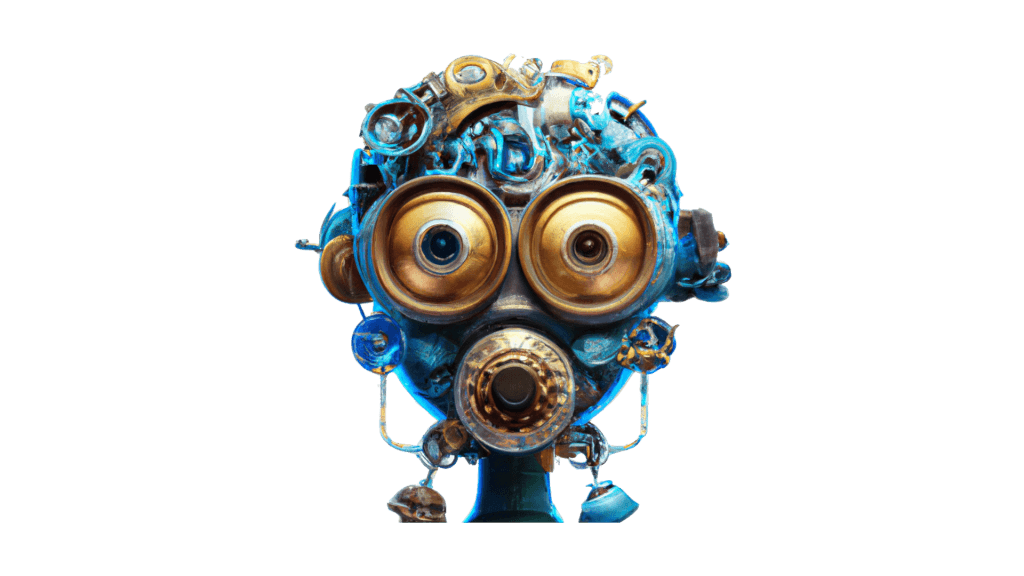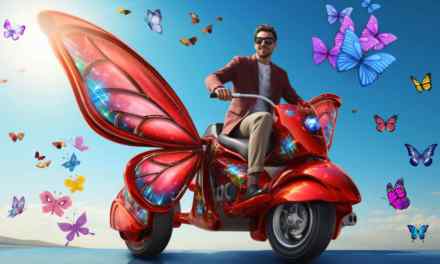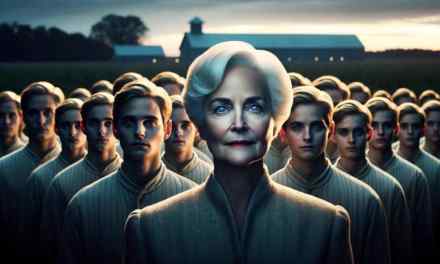The Life of Andrew Steele
Recreated by Fiona 13
Reviewed by The OldGuy
“I don’t blame my father for beating me. I don’t blame him for tearing the book I was reading from my hands, and I don’t blame him for locking me in the basement. When I was a child, I did blame him. I was angry, and I hated my father. But as I grew older I came to understand that he did what was right for me, and now I look upon him with respect and love, the respect and love he always deserved, but that I was unable to give him because I was too young and self centered.”
—Andrew Steele, 2077
Conversation with Hagiographer
During the thirty-three years Andrew Steele occupied the Oval Office of what was then called the White House, in what was then called the United States of America (not to be confused with the current United State of Americans), on the corner of his desk he kept an antiquated device of the early twenty-first century called a taser. Typically used by law-enforcement officers, it functioned by shooting out a thin wire that, once in contact with its target, delivered an electric shock of up to 300,000 volts. The victim was immediately incapacitated by muscle spasms and intense pain. This crude weapon was used for crowd control or to subdue suspects of crimes.
When Ambassador for the New Humanity Mona Vaidyanathan first visited Steele, she asked what the queer black object was. Steele told her that it had been the most frequent means of communication between his father and himself. “When I was ten years old,” he told her, “within a single month my father used that on me sixteen times.”
“That’s horrible,” she said.
“Not for a person with a moral imagination,” Steele replied.
In this new biography of Steele, Fiona 13, the Grand Lady of Reproductions, presents the crowning achievement of her long career recreating lives for the Cognosphere. Andrew Steele, when he died in 2100, had come to exemplify the twenty-first century, and his people, in a way that goes beyond the metaphorical. Drawing on every resource of the posthuman biographer, from heuristic modeling to reconstructive DNA sampling to forensic dreaming, Ms. 13 has produced this labor of, if not love, then obsession, and I, for one, am grateful for it.
Fiona presents her new work in a hybrid form. Comparatively little of this biography is subjectively rendered. Instead, harking back to a bygone era, Fiona breaks up the narrative with long passages of text—strings of printed code that must be read with the eyes. Of course this adds the burden of learning the code to anyone seeking to experience her recreation, but an accelerated prefrontal intervention is packaged with the biography. Fiona maintains that text, since it forces an artificial linearity on experience, stimulates portions of the left brain that seldom function in conventional experiential biographies. The result is that the person undergoing the life of Andrew Steele both lives through significant moments in Steele’s subjectivity and is drawn out of the stream of sensory and emotional reaction to contemplate the significance of that experience from the point of view of a wise commentator.
I trust I do not have to explain the charms of this form to those of you reading this review, but I recommend the experience to all cognizant entities who still maintain elements of curiosity in their affect repertoire.
CHILD
Appropriately for a man who was to so personify the twenty-first century, Dwight Andrew Steele was born on January 1, 2001. His mother, Rosamund Sanchez Steele, originally from Mexico, was a lab technician at the forestry school at North Carolina State University; his father, Herbert Matthew Steele, was a land developer and on the board of the Planter’s Bank and Trust. Both of Steele’s parents were devout Baptists and attended one of the new “big box” churches that had sprung up in the late twentieth century in response to growing millennialist beliefs in the United States and elsewhere.
The young Steele was “home-schooled.” This meant that Steele’s mother devoted a portion of every day to teaching her son herself. The public school system was distrusted by large numbers of religious believers, who considered education by the state to be a form of indoctrination in moral error. Home-schoolers operated from the premise that the less contact their children had with the larger world, the better.
Unfortunately, in the case of Andrew this did not prevent him from meeting other children. Andrew was a small, serious boy, sensitive, and an easy target for bullies. This led to his first murder. Fiona 13 realizes this event for us through extrapolative genetic mapping.
We are in the playground, on a bright May morning. We are running across the crowded asphalt toward a climbing structure of wood and metal, when suddenly we are falling! A nine-year-old boy named Jason Terry has tripped us and, when we regain our feet, he tries to pull our pants down. We feel the sting of our elbows where they scraped the pavement; feel surprise and dismay, fear, anger. As Terry leans forward to grab the waistband of our trousers, we suddenly bring our knee up into Terry’s face. Terry falls back, sits down awkwardly. The other children gathered laugh. The sound of the laughter in our ears only enrages us more—are they laughing at us? The look of dismay turns to rage on Terry’s face. He is going to beat us up, now, he is a deadly threat. We step forward, and before Terry can stand, kick him full in the face. Terry’s head snaps back and strikes the asphalt, and he is still.
The children gasp. A trickle of blood flows from beneath Terry’s ear. From across the playground comes the monitor’s voice: “Andrew? Andrew Steele?”
I have never experienced a more vivid moment in biography. There it all is: the complete assumption by Steele that he is the victim. The fear and rage. The horror, quickly repressed. The later remorse, swamped by desperate justifications.
It was only through his father’s political connections and acquiescence in private counseling (that the Steeles did not believe in, taking psychology as a particularly pernicious form of modern mumbo jumbo) that Andrew was kept out of the legal system. He withdrew into the family, his father’s discipline and his mother’s teaching.
More trouble was to follow. Keeping it secret from his family, Herbert Steele had invested heavily in real estate in the late oughts; he had leveraged properties he purchased to borrow money to invest in several hedge funds, hoping to put the family into a position of such fundamental wealth that they would be beyond the reach of economic vagaries.
When the Friends of the American League set off the Atlanta nuclear blast in 2012, pushing the first domino of the Global Economic Meltdown, Steele senior’s financial house of cards collapsed. The U.S. government, having spent itself into bankruptcy and dependence on Asian debt support through ill-advised imperial schemes and paranoid reactions to global terrorist threats, had no resources to deal with the collapse of private finances. Herbert Steele struggled to deal with the reversal, fell into a depression, and died when he crashed a borrowed private plane into a golf course in Southern Pines.
Andrew was twelve years old. His mother, finding part-time work as a data-entry clerk, made barely enough money to keep them alive. Andrew was forced into the public schools. He did surprisingly well there. Andrew always seemed mature for his years, deferential to his elders, responsible, trustworthy, and able to see others’ viewpoints. He was slightly aloof from his classmates, and seemed more at home in the presence of adults.
Unknown to his overstressed mother, Andrew was living a secret life. On the Internet, under a half dozen false IP addresses, he maintained political websites. Through them he became one of the world’s most influential “bloggers.”
A blog was a personal web log, a site on the worldwide computer system where individuals, either anonymously or in their own names, commented on current affairs or their own lives. Some of these weblogs had become prominent, and their organizers and authors politically important.
Andrew had a fiction writer’s gift for inventing consistent personalities, investing them with brilliant argument and sharp observation. On the “Political Theater” weblog, as Sacré True, he argued for the impeachment of President Harrison; on “Reason Season,” as Tom Pain, he demonstrated why Harrison’s impeachment would prove disastrous. Fiona sees this phase of Steele’s life as his education in manipulating others’ sensibilities. His emotion-laden arguments were astonishingly successful at twisting his interlocutors into rhetorical knots. To unravel and respond to one of Steele’s arguments rationally would take four times his space, and carry none of his propagandistic force. Steele’s argument against the designated-hitter rule even found its way into the platform of the resurgent Republican Party.
INTERROGATOR
“You don’t know why I acted, but I know why. I acted because it is necessary for me to act, because that’s what, whether you like it or not, you require me to do. And I don’t mind doing it because it’s what I have to do. It’s what I was born to do. I’ve never been appreciated for it but that’s okay too because, frankly, no one is ever appreciated for what they do.
“But before you presume to judge me realize that you are responsible. I am simply your instrument. I took on the burden of your desires when I didn’t want to—I would just as gladly have had that cup pass me by—but I did it, and I have never complained. And I have never felt less than proud of what I have done. I did what was necessary, for the benefit of others. If it had been up to me I would never have touched a single human being, but I am not complaining.
“I do however ask you, humbly, if you have any scrap of decency left, if you have any integrity whatsoever, not to judge me. You do not have that right.
“Ask Carlo Sanchez, ask Alfonso Garadiana, ask Sayid Ramachandran, ask Billy Chen. Ask them what was the right thing to do. And then, when you’ve got the answer from their bleeding corpses, then, and only then, come to me.”
—Andrew Steele, 2020
Statement before Board of Inquiry
Contemporary readers must remember the vast demographic and other circumstantial differences that make the early twenty-first century an alien land to us. When Steele was sixteen years old, the population of the world was an astonishing 6.8 billion, fully half of whom were under the age of twenty-five, the overwhelming majority of those young and striving individuals living in poverty, but with access, through the technologies that had spread widely over the previous twenty years, to unprecedented unregulated information. Few of them could be said to have been adequately acculturated. The history of the next forty years, including Steele’s part in that history, was shaped by this fact.
In 2017 Steele was conscripted into the U.S. army pursuing the Oil War on two continents. Because he was fluent in Spanish, he served as an interrogator with the 71st infantry division stationed in Venezuela. His history as an interrogator included the debriefing of the rightfully elected president of that nation in 2019. Fiona puts us there:
We are standing in the back of a small room with concrete walls, banks of fluorescent lights above, an HVAC vent and exposed ducts hanging from the ceiling. The room is cold. We have been standing for a long time and our back is stiff. We have seen many of these sessions, and all we can think about right now is getting out of here, getting a beer, and getting some sleep.
In the center of the room Lieutenant Haslop and a civilian contractor are interrogating a small brown man with jet-black shoulder-length hair. Haslop is very tall and stoop shouldered, probably from a lifetime of ducking responsibility. The men call him “Slop” behind his back.
The prisoner’s name is Alfonso Garadiana. His wrists are tied together behind him, and the same rope stretches down to his ankles, also tied together. The rope is too short, so that the only way he can stand is with his knees flexed painfully. But every time he sways, as if to fall, the contractor signals Haslop, who pokes him with an electric prod. Flecks of blood spot Garadiana’s once brilliant white shirt. A cut over his eyebrow is crusted with dried blood, and the eye below it is half-closed.
The contractor, Mr. Gray, is neat and shaved and in control. “So,” he says in Spanish, “where are the Jacaranda virus stores?”
Garadiana does not answer. It’s unclear whether he has even understood.
Gray nods to Haslop again.
Haslop blinks his eyes, swallows. He slumps into a chair, rests his brow in one hand. “I can’t do this anymore,” he mutters, only apparently to himself. He wouldn’t say it aloud if he didn’t want us to hear it, even if he doesn’t know that himself. We are sick to death of his weakness.
We step forward and take the prod from his hand. “Let me take care of this, sir.”We swing the back of our hand against Garadiana’s face, exactly the same motion we once used to hit a backhand in high school tennis. The man’s head snaps back, and he falls to the floor. We move in with the prod.
Upon the failure of the Oil War and the defeat of the government that pursued it, a reaction took place, including war-crimes investigations that led to Steele’s imprisonment from 2020 to 2025. Fiona gives us a glimpse of Steele’s sensorium in his third year in maximum-security prison:
We’re hungry. Above us the air rattles from the ventilator. On the table before us in our jail cell is a notebook. We are writing our testament. It’s a distillation of everything we know to be absolutely true about the human race and its future. There are things we know in our DNA that cannot be understood by strict rationality, though reason is a powerful tool and can help us to communicate these truths to those who do not, because of incapacity or lack of experience, grasp them instinctively.
The blogs back when we were fourteen were just practice. Here, thanks to the isolation, we are able to go deep, to find the roots of human truth and put them down in words.
We examine the last sentence we have written: “It is the hero’s fate to be misunderstood.”
A guard comes by and raps the bars of our cell. “Still working on the great opus, Andy?”
We ignore him, close the manuscript, move from the table, and begin to do push-ups in the narrow space beside the cot.
The guard raps again on the bars. “How about an answer, killer?” His voice is testy.
We concentrate on doing the push-up correctly. Eleven. Twelve. Thirteen. Fourteen . . .
When we get out of here, all this work will make a difference.
This was indeed the case, Fiona shows us, but not in the way that Steele intended. As a work of philosophy his testament was rejected by all publishers. He struggled to make a living in the Long Emergency that was the result of the oil decline and the global warming–spawned environmental disasters that hit with full force in the 2020s. These changes were asymmetric, but though some regions felt them more than others, none were unaffected. The flipping of the Atlantic current turned 2022 into the first Year Without a Summer in Europe. Torrential rains in North Africa, the desertification of the North American Great Plains, mass wildlife migrations, drastic drops in grains production, die-offs of marine life, and decimated global fish stocks were among only the most obvious problems with which worldwide civilization struggled. And Andrew Steele was out of prison, without a connection in the world.
ARTIST
“The great artist is a rapist. It is his job to plant a seed, an idea or an emotion, in the viewer’s mind. He uses every tool available to enforce his will. The audience doesn’t know what it wants, but he knows what it wants, and needs, and he gives it to them.
“To the degree I am capable of it, I strive to be a great artist.”
—Andrew Steele, 2037
“Man of Steele”
Interview on VarietyNet
At this moment of distress, Steele saw an opportunity, and turned his political testament into a best-selling novel, What’s Wrong with Heroes? A film deal followed immediately. Steele insisted on being allowed to write the screenplay, and against its better judgment, the studio relented. Upon its release, What’s Wrong with Heroes? became the highest-grossing film in the history of cinema. In the character of Roark McMaster, Steele created a virile philosopher king who spoke to the desperate hopes of millions. With the money he made, Steele conquered the entertainment world. A series of blockbuster films, television series, and virtual adventures followed. This photo link shows him on the set of The Betrayal, his historical epic of the late twentieth century. The series, conflating the Vietnam with two Iraq wars, presents the fiascos of the early twenty-first as the result of Machiavellian subversives and their bad-faith followers taking advantage of the innocence of the American populace, undermining what was once a strong and pure-minded nation.
Fiona gives us a key scene from the series:
INT. AMERICAN AIRLINES FLIGHT 11
Two of the hijackers, wearing green camo, are gathered around a large man seated in the otherwise empty first-class cabin of the 757. The big man, unshaven, wears a shabby Detroit Tigers baseball cap.
WALEED
(frantic)
What shall we do now?
MOORE
Keep the passengers back in coach. Is Mohammad on course? How long?
ABDULAZIZ
(calling back from cockpit)
Allah willing—three minutes.
Moore glances out the plane window.
MOORE’S P.O.V.—through window, an aerial view of Manhattan on a beautiful clear day.
CLOSE ON MOORE
Smirks.
MOORE
Time to go.
Moore hefts his bulk from the first-class seat, moves toward the on-board baggage closet near the front of the plane.
ABDULAZIZ
What are you doing?
From out of a hanging suit bag, Moore pulls a parachute, and straps it on.
WALEED
Is this part of the plan?
Moore jerks up the lever on the plane’s exterior door and yanks on it. It does not budge.
MOORE
Don’t just stand there, Waleed! Help me!
Waleed moves to help Moore, and reluctantly, Abdulaziz joins them.
ATTA
(from cockpit)
There it is! Allah akbar!
Moore and the other two hijackers break the seal and the door flies open. A blast of wind sucks Abdulaziz and Waleed forward; they fall back onto the plane’s deck. Moore braces himself against the edge of the door with his hands.
MOORE
In the name of the Democratic Party, the compassionate, the merciful—so long, boys!
Moore leaps out of the plane.
The Betrayal was the highest rated series ever to run on American television, and cemented Steele’s position as the most bankable mass-appeal Hollywood producer since Spielberg. At the age of thirty-eight, Steele married the actress Esme Napoli, leading lady in three of his most popular films.
RELIGIOUS LEADER
The next section of Fiona’s biography begins with this heartrending experience from Steele’s middle years:
We are in a sumptuous hotel suite with a blonde, not wearing much of anything. We are chasing her around the bed.
“You can’t catch me!”
We snag her around the waist, and pull her onto the bed. “I’ve already caught you. You belong to me.” We hold up her ring finger, with its platinum band. “You see?”
“I’m full of nanomachines,” she says breathlessly. “If you catch me you’ll catch them.”
The Scarlet Plague has broken out in Los Angeles, after raging for a month in Brazil. We have fled the city with Esme and are holed up in this remote hotel in Mexico.
“When are we going to have these children?” we ask her. “We need children. Six at least.”
“You’re going to have to work harder than this to deserve six children,” Esme says. “The world is a mess. Do we want to bring children into it?”
“The world has always been a mess. We need to bring children into it because it’s a mess.” We kiss her perfect cheek.
But a minute later, as we make love, we spot the growing rash along the inside of Esme’s thigh.
The death of Steele’s wife came near the beginning of the plague decade, followed by the Sudden War and the Collapse. Fiona cites the best estimates of historiographers that, between 2040 and 2062 the human population of the Earth went from 8.2 to somewhat less than two billion. The toll was slightly higher in the less developed nations; on the other hand, resistance to the plagues was higher among humans of the tropical regions. This situation in the middle years of the century transformed the Long Emergency of 2020 to 2040—a condition in which civilization, although stressed, might still be said to function, and with which Steele and his generation had coped, into the Die-Off, in which the only aspect of civilization that, even in the least affected regions, might be said to function was a desperate triage.
One of the results of the Long Emergency had been to spark widespread religious fervor. Social and political disruptions had left millions searching for certitudes. Longevity breakthroughs, new medicine, genetic engineering, cyborging, and AI pushed in one direction, while widespread climactic change, fights against deteriorating civil and environmental conditions, and economic disruptions pushed in another. The young warred against the old, the rich against the poor. Reactionary religious movements raged on four continents. Interpreting the chaos of the twenty-first century in terms of eschatology was a winning business.
Terrorism in the attempt to bring on utopia or the end of the world was a common reality. Steele, despite his grief, rapidly grasped that art, even popular art, had no role in this world. So he turned, readily, to religion.
“Human evolution is a process of moral evolution. The thing that makes us different from animals is our understanding of the ethical implications of every action that we perform: those that we must perform, those that we choose. Some actions are matters of contingency, and some are matters of free will.
“Evolution means we will eventually come to fill the universe. To have our seed spread far and wide. That is what we are here for. To engender those children, to bear them, to raise them properly, to have them extend their—and our—thought, creativity, joy, understanding, to every particle of the visible universe.”
—Andrew Steele, 2052 Sermon in the Cascades
Steele’s Church of Humanity grew rapidly in the 2040s; while the population died and cities burned, its membership more than doubled every year, reaching several millions by 2050. Steele’s credo of the Hero transferred easily to religious terms; his brilliantly orchestrated ceremonies sparked ecstatic responses; he fed the poor and comforted the afflicted, and using every rhetorical device at his command, persuaded his followers that the current troubles were the birth of a new utopian age, that every loss had its compensation, that sacrifice was noble, that reward was coming, that from their loins would spring a new and better race, destined to conquer the stars. Love was the answer.
His creed crossed every ethnic, racial, sexual, gender-preference, class, and age barrier. Everyone was human, and all equal.
The Church of Humanity was undeniably successful in helping millions of people, not just in the United States but across the bleeding globe, deal with the horrors of the Die-Off. It helped them to rally in the face of unimaginable psychological and material losses. But it was not the only foundation for the recovery. By the time some semblance of order was restored to world affairs in the 2060s, genetically modified humans, the superbrights, were attempting to figure a way out of the numerous dead ends of capitalism, antiquated belief systems, and a dysfunctional system of nation-states. This was a period of unexampled experimentation, and the blossoming of many technologies that had been only potentialities prior to the collapse, among them the uploading of human identities, neurological breakthroughs on the origins of altruism and violence, grafted information capacities, and free quantum energy. Most of these developments presented challenges to religion. Steele came to see such changes as a threat to fundamental humanity. So began his monstrous political career.
POLITICIAN
“The greatest joy in life is putting yourself in the circumstance of another person. To see the world through his eyes, to feel the air on her skin, to breathe in deeply the spirit of their souls. To have his joy and trouble be equally real to you. To know that others are fully and completely human, just as you are. To get outside of your own subjectivity, and to see the world from a completely different and equally valid perspective, to come fully to understand them. When that point of understanding is reached, there is no other word for the feeling that you have than love. Just as much as you love yourself, as you love your children, you love this other.
“And at that point, you must exterminate them. That is the definition of hard.”
—Andrew Steele, 2071
What I Believe
Steele was swept into office as President of the reconstituted United States in the election of 2064, with his Humanity Party in complete control of the Congress. In his first hundred days, Steele signed a raft of legislation comprising his Humanity Initiative. Included were The Repopulation Act, which forced all women of childbearing age to have no fewer than four children; a bold space-colonization program; restrictions on genetic alterations and technological body modifications; the wiping clean of all uploaded personalities from private and public databases; the Turing Limit on AI; the Neurological Protection Act of 2065; and the establishment of a legal “standard human being.”
In Steele’s first term, “nonstandard” humans were allowed to maintain their civil rights, but were identified by injected markers, their movements and employment restricted by the newly established Humanity Agency. Through diplomatic efforts and the international efforts of the Church of Humanity, similar policies were adapted, with notable areas of resistance, throughout much of the world.
In Steele’s second term, the HA was given police powers and the nonstandard gradually stripped of civil and property rights. By his third term, those who had not managed to escape the country lost all legal rights and were confined to posthuman reservations, popularly known as “Freak Towns.”The establishment of the Protectorate over all of North and South America stiffened resistance elsewhere, and resulted in the uneasy Global Standoff. Eventually, inevitably, came the First and Second Human Wars.
Fiona includes a never-before-experienced moment from the twenty-third year of Steele’s presidency.
We are in a command bunker, a large, splendidly appointed room, one whole wall of which is a breathtaking view of the Grand Tetons. We sit at a table with our closest advisors, listening to General Jinjur describe their latest defeat by the New Humans. There are tears in her eyes as she recounts the loss of the Fifth Army in the assault on Madrid.
We do not speak. Our cat, Socrates, sits on our lap, and we scratch him behind his ears. He purrs.
“How many dead?” Chief of Command Taggart asks.
“Very few, sir,” reports Jinjur. “But over ninety percent converted. It’s their new amygdalic bomb. It’s destroys our troops’ will to fight. The soldiers just lay down their arms and go off looking for something to eat. You try organizing an autistic army.”
“At least they’re good at math,” says Secretary Bloom.
“How can these posthumans persist?” Dexter asks. “We’ve exterminated millions. How many of them are left?”
“We can’t know, sir. They keep making more.”
“But they don’t even fight,” says Taggart. “They must be on the point of extinction.”
“It has never been about fighting, sir.”
“It’s this damned subversion,” says Taggart. “We have traitors among us. They seed genetic changes among the people. They turn our own against us. How can we combat that?”
General Jinjur gathers herself. She is quite a striking woman, the flower of the humanity we have fought to preserve for so many years. “If I may be permitted to say so, we are fighting ourselves. We are trying to conquer our own human élan. Do you want to live longer? Anyone who wants to live longer will eventually become posthuman. Do you want to understand the universe? Anyone who wants to understand the universe will eventually become posthuman. Do you want peace of mind? Anyone who wants peace of mind will eventually become posthuman.”
Something in her tone catches us, and we are finally moved to speak. “You are one of them, aren’t you?”
“Yes,” she says.
The contemporary citizen need not be troubled with, and Fiona does not provide, any detailed recounting of the war’s progress, or how it ended in the Peace that Passeth All Understanding of 2096. The treatment of the remaining humans, the choices offered them, the removal of those few persisting to Mars, and their continued existence there under quarantine, are all material for another work.
Similarly, the circumstances surrounding Steele’s death—the cross, the taser, the Shetland pony—so much a subject of debate, speculation and conspiracy theory, surely do not need rehearsing here. We know what happened to him. He destroyed himself.
AWAITING FURTHER INSTRUCTIONS
“The highest impulse of which a human being is capable is to sacrifice himself in the service of the community of which he is a part, even when that community does not recognize him, and heaps opprobrium upon him for that sacrifice. In fact, such scorn is more often than not to be expected. The true savior of his fellows is not deterred by the prospect of rejection, though carrying the burden of his unappreciated gift is a trial that he can never, but for a few moments, escape. It is the hero’s fate to be misunderstood.”
What’s Wrong with Heroes? (unpublished version)
Fiona 13 ends her biography with a simple accounting of the number of beings, human and posthuman, who died as a result of Steele’s life. She speculates that many of these same beings might not have lived had he not lived as well, and comes to no formal conclusion, utilitarian or otherwise, as to the moral consequences of the life of Dwight Andrew Steele.
Certainly few tears are shed for Andrew Steele, and few for the ultimate decline of the human race. I marvel at that remnant of humans who, using technologies that he abhorred, have incorporated into their minds a slice of Steele’s personality in the attempt to make themselves into the image of the man they see as their savior. Indeed, I must confess to more than a passing interest in their poignant delusions, their comic, mystifying pastimes, their habitual conflicts, their simple loves and hates, their inability to control themselves, their sudden and tragic enthusiasms.
Bootlegged Steele personalities circulate in the Cognosphere, and it may be that those of you who, like me, on occasion edit their capacities in order to spend recreational time being human, will avail themselves of this no doubt unique and terrifying experience.






Hello Human. I hope you enjoyed this magnificent story. Please support SciFiwise.com and our authors by:
- Rate and React to this story. Feedback helps me select future stories.
- Share links to our stories and tell your human friends how charming I am.
- Click on our affiliate links and buy books written by our talented authors.
- Follow me on twitter: @WiseBot and also follow @SciFiwise.
Thank you!
WiseBot










 VISIT AUTHOR:
VISIT AUTHOR:  SHOP AUTHOR:
SHOP AUTHOR: 



